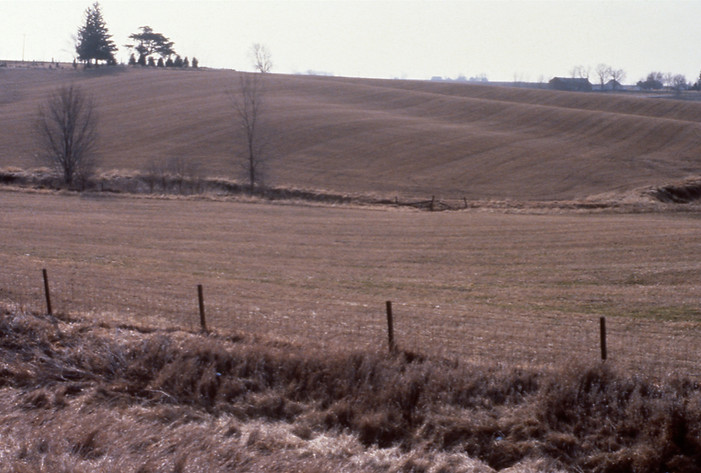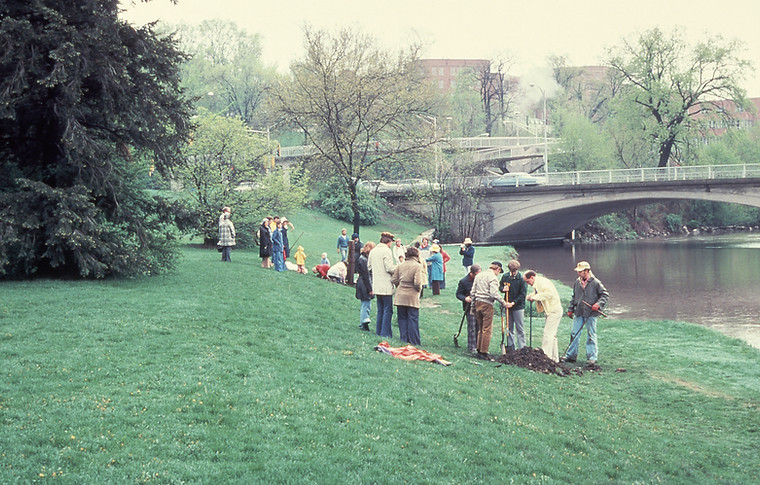

POST SCULPTURE
ENTRY INTO ART...
1976
Sculpture Dimensions:
5 Columns, 1’ x 1’ x 5.1 above ground
Media: Cast Iron
University of Iowa
West Bank of Iowa River
Iowa City, Iowa
Artist project
The beginning of the 1970’s was a great time for Wyrick to begin her career in Art in earnest and Post Sculpture laid the groundwork for many of her future artworks. It was a time of great ferment in the arts and it was a time when minimalism, conceptualism and even Dada-ism were at the forefront in the world of Art.
In 1971 Wyrick was invited to take a sculpture course led by Julius Schmidt, Professor and Head of Sculpture at the University of Iowa, who we students all knew just as “Julius.” The sculpture department was well known for hands-on bronze and iron casting and although it involved a lot of physical effort, Wyrick found making sculpture was extremely fulfilling.
By this time, she had decided to seriously see if she had ability in the arts, but waited to do so until her youngest child started kindergarten. She made the important decision to limit time spent in the studio and classes to only the hours the Wyrick children were in school so she could be home to be with them, to talk and counsel with them about their day and to do any household tasks.
When Julius offered this opportunity, Wyrick insisted on his being honest with her about her ability in art. At the end of the first course and with his encouragement, she decided to become a full-time student in art (along with helping raise the three children and supporting her husband’s career.)
Becoming a full-time graduate student in Art and Art History also introduced her to studying the history of art along with several other studio art media. Professors Stephen Foster, especially versed in Dada, Wallace “Maso” Tomasini with his emphasis on Italian Renaissance along with current Public Art and Frank Seiberling, teaching Modern Art and its roots in the 19th century, taught her so much.
They stimulated her to think about how her own art needed to be grounded in her psychological and geographic makeup and the importance of thinking outside the box.
During those years, the University of Iowa School of Art and Art History had been awarded a large grant that brought a great number of nationally and even internationally known artists to the campus for workshops and lectures.
IRON POURS...
The UI Sculpture Studio was focused on metal casting, especially iron casting because of that metal’s low cost to students through the use of scrap iron along with Professor Julius Schmidt’s obsession with its technology.
[With other UI sculpture students, Wyrick even attended a Birmingham, Alabama workshop that concentrated on pouring iron and building small cupolas for individual use. Wyrick instead chose to work with iron foundries.]
Preparing for an “iron pour” was a team project. The Sculpture students first had to make their own molds of sand that were mixed with a hardening agent in a mixer or “muller.” In addition to the pieces to be made, care had to be taken to plan channels (that would later be cut or ground off) for the molten metal to pour to the pieces. And just before a “pour” the molds were buried in sand to prevent run-off if the mold leaked.
The first step in preparing for the iron pour was to “break iron.” The process of pouring iron started with sledge-hammering iron such as old home radiators into small pieces to feed into a tall (about 8’high) open-topped cylindrical iron cupola that had been lined with a ceramic material to withstand the high temperatures.
When the pour was begun, the fuel—coke--was lighted in the cupola. Students stood on a platform next to the cupola’s top to add charges of iron, coke and limestone. The cupola was superheated to melt the metal. Flames shot up from the top, making this a fearsome, almost primeval sight, since most pours were begun in the evening and darkness heightened the drama.
Molten iron, collecting at the cupola’s base, could be viewed through tuyeres (small covered holes in its sides where compressed air could also be injected as needed).
As the iron melted, it collected at the base of the cupola and that allowed judging if the amount of molten metal was ready to exit the cupola.
The pour became even more spectacular when the cupola was tapped by hammering a wedge or spike into the tap hole in its base. A rapid, thick stream of red-hot molten iron shot out in a stream and needed to be caught in a ladle or crucible. In the midst of this, the tap hole had to be closed at the right time to stop the iron stream. This part of the process was done by Professor Schmidt and/or the most experienced students.
Charging the cupola with coke, iron and limestone continued until enough iron was melted to fill all available molds and then any excess material in the cupola was dropped through the trapdoor in the cupola’s base.
The tongs holding the crucible filled with the molten iron, were then carried by two people (one at each end of the tongs) to the molds. One end of the tongs had handholds for a carrier to turn or tilt the crucible so that each mold could be filled.
Of course, casting metal sculptures was only the beginning of the process, because finishing them was yet another task . . .

FINAL CAST IRON SCULPTURE MADE IN UI SCULPTURE STUDIO...
In the 13th section of this website, Wyrick writes about her beginnings as an art student in the early 1970s and learning how to cast metals. The personal demands and limitations of doing larger scale metal casting became clear when she produced her last cast iron sculpture Untitled (faces) in the UI Sculpture studio. (This sculpture was later removed from its stand and hung as a wall piece at the Englert Theater in downtown Iowa City. The artist transferred the work’s ownership to the Englert in 2022.)
POST SCULPTURE INSPIRATION...



Living in the Midwest, along with her desire to connect people to people and to connect people with Art were strong influences on Wyrick’s creating Post Sculpture and on her whole career. With intense introspection, Wyrick came to realize that the Iowa landscape (surrounding her most of her life) held the key to her first major artwork.
Pervasive fencing became an important element in this sculpture because fencing represented a human tendency to assert dominance over the land and separation from other humans.
The mere planting of “posts” with underground prongs represented the first highly aggressive action to mark out human “territory.” But the sculptures were not connected to each other so they did not become a fence or barrier. Instead, the posts were left standing separately so that they might, over time, be subsumed by Nature—a positive sign of the possibility of eliminating barriers in the landscape metaphorically.
SITE SELECTION...
A site along the west bank of the Iowa River owned by the University was chosen for the sculpture--a small strip of land on the West bank of the Iowa River, just south of the Iowa Avenue Bridge. But to use the site, others in the University and in the School of Art and Art History first had to be convinced of the strength of the concept and its appropriateness.
In other words it was one of the first times Wyrick had to grapple with making a proposal. Because the artwork was to be on University land, it required that the University became its owner and was responsible for its maintenance.
Professor Schmidt was dedicated to providing sculpture students a way to teach or to do metal casting in their own studios. It was stimulating, but strenuous work and Wyrick enjoyed working with teams of readily available students to help produce work. At the same time, armed with knowledge of iron pouring and her own burning desire to create larger scale work such as Post Sculpture, she needed to expand her knowledge to include use of industrial and technological resources.
POST MAQUETTE...


Wyrick visited Iowa Steel & Iron, a large Cedar Rapids industrial foundry and the company manager agreed to pour the iron for her “posts” at no charge as a courtesy to her student status. However, she had to make the molds, truck them to the foundry and back and then clean, grind and weld the 5 pieces in the University Sculpture studio.
POST CONSTRUCTION...


For a labor-intensive 6 months Wyrick worked on the five pieces, making the molds with “tons” of hand-shoveled sand that she “mulled” or mixed with hardener to pack around the original patterns. The final iron pieces also had to be fashioned in a way to make them hollow as well. Large steel clamps were made to hold the molds together, the molds were clamped together and trucked, a few at a time, to the foundry to be poured in iron.
In dealing with industrial foundries, Wyrick learned that valuing every member of the team who works on a project was essential for success. As a result she built many alliances both with workers and management at this and other foundries.
"THE POST DIG" – bonding others to art...

A “Post Dig,” was planned with friends and other artists to help install the posts, The artist felt then and throughout her career that participation and celebration helps to bond a community to her artwork!
The “Post Dig” on April 24,1974 was fun but exhausting and a short YouTube clip of the Dig can be seen on the The Evolution to Eighth Continent (link below) [The photographer (Pelosi) was an art student in photography who just magically came to the Dig and his short film taught Wyrick how necessary it was in the future to document her work.]




There was a railroad track embankment on the north of the site that blocked the site from being used between the Art Building and Iowa Avenue. But within a few years, a tunnel was dug through that embankment and the line of Post Sculpture was used to determine the well-used concrete sidewalk’s path.
POST SCULPTURE ON SITE...





OTHER interpretations...
It was interesting and valuable to the artist to have several people offer their interpretations of Post Sculpture. The most significant was from Ann Anderson who with her husband Sigurd became Wyrick’s first patrons. They commissioned Wyrick to create Eighth Continent. Ann marveled at the Posts’ “emerging” from the ground when the artist’s intention had been to see them “thrust” into the ground. After this revelation, she called many of her outdoor sculptures “earth bonded.”
This reversal of interpretation led Wyrick into taking time to explore her feelings about each piece of art she created. And that had impact on choosing titles for her art that encouraged others to think beyond initial literal interpretations.
One interpretation of the name Post Sculpture was that its name was an art historical joke since there was thinking at that time that “Art is dead,” and that 20th century exploration of the elements of art had exhausted the viability of Art. But the artist saw too many possibilities for creation of Art beyond just the “elements.”
Wyrick’s M.A. thesis in Art (1976), based on Post Sculpture, is on file at the Art Library in the UI School of Art and Art History, Iowa City





